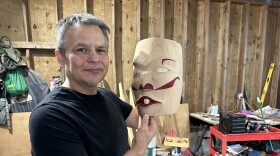It’s been called the most significant environmental story of this century: the removal of hydroelectric dams on the Elwha River, near Port Angeles.
The project is only partly done; Elwha Dam, one of two structures holding back salmon and steelhead runs, has been fully removed, and the other, Glines Canyon Dam, will be out next fall. But the landscape is already changing dramatically.
The Return of Salmon
The Elwha River runs through Olympic National Park, which will soon provide 70 miles of nearly pristine spawning habitat for fish, if they can get there. For more than a century, their passageway was blocked to provide hydroelectric power. Now the wall of turbines is gone, and the fish appear to be coming back.

“That’s a fairly tough passageway right there. Takes some energetic salmon, with just the right flows for the salmon, to come through there,” said Robert Elofson as he looked down 100-foot rock walls into the canyon where water full of silty sediment rushed through.
Elofson, director of river restoration for the Lower Elwha Klallam Tribe, says he’s been all smiles lately, because there is almost no trace left of the structure that decimated the tribe when it went up more than a hundred years ago.
This dam was built in violation of the law, without any salmon ladders. The fish never stopped trying to come up to their native spawning ground. They used to bump their heads on the wall. Some found their way around it in side channels.
But now that the Elwha Dam is gone, they’re free to swim upriver.
“The chum, pinks, Coho and Chinook have all made it past this site,” said Elofson.
This year, the tribe reported its largest run of Chinook in decades. It’s unclear, though, whether this grand experiment in dam removal will work. All the fish scientists will say they know for sure is that there are many more spawning nests this year than last—about three times as many.
But the ecosystem appears to be bouncing back, and there’s no doubt that the landscape is changing.
Bathtub Rings Where a Reservoir Once Stood

“You can see where the old river channels used to go," said PatteHappe, lead wildlife biologist at Olympic National Park, as she walked through a soft plateau that was once the bottom of Lake Mills. The reservoir was slowly drawn down in preparation for the dam removal. Now, Happe says, you can see where the water once filled it by looking at the hillsides: if you squint, it almost looks like there are bathtub rings about 20 feet above.
“You can kind of see. There’s the old waterline,” she said.
Now there are plants sprouting on gravel bars, many of them planted by re-vegetation crews to give nature a boost. And, Happe says, there are other signs of nature returning. For one, her team has collared two elk they’re tracking. One has been hanging around the former lakebed.

“Last year, he discovered the reservoir and the portions that were re-vegetated, and he spent a lot of the winter there,” Happe said. “Somebody has to discover it. He discovered it, he used it. So it will be interesting to see who else does that, that we can tell.”
Happe says wildlife officials are still figuring out how to monitor everything in a cost-effective manner. Right now, there are at least 3,000 elk in the park. They believe if they restore the ecosystem, a variety of other wildlife will come back, from salmon on up the food chain to bears and beavers, even eagles and otters.
“But they need something to eat, and they need shelter. So we’re waiting for that to come back,” Happe said.
Beach, Once Rapidly-Eroding, Now Growing

Downstream at the river’s mouth, the beach is coming back—literally growing, says Ian Miller, a near-shore scientist who studies the sediment and what lives in and around it.
“This represents about 10 to 15 feet of new deposition. So there’s 10, 15 feet all deposited in the past year,” said Miller with Washington Sea Grant. “It’s very nice.”
Miller’s team is studying how dam removal will influence what used to be a very rapidly-eroding beach. The team is also tracking everything that arrives on the beach and how it moves around.

“In terms of survey work, the hazards have changed from risking rolling an ankle on a slippery cobble to getting caught in quick sand,” Miller said.
Miller says what was once a very simple, stripped-down ecosystem is transforming into an increasingly complex one with huge amounts of woody debris and tiny pieces of driftwood that had been held back by the dam.
“This was one of the sort of early surprises: seeing this, expecting sediment. Really seeing big piles of mulch, essentially, very fine wood,” he said.
Found: Dungeness Crab
Miller also works with a group of researchers who study how dam removal affects the marine biological community that lives offshore.
And one of his interns, a young man named Karsten Turrey, found the first Dungeness crab on the beach in nearly a century. A member of the Lower-Elwha Klallum Tribe, 17-year-old Turrey volunteered to help with Miller’s October survey of the new arrivals on the beach.
“Well, we just saw [the crab],” said Turrey. “Scooped it up and it was there.”
The researchers say it will be years before they say anything conclusive about what’s happening on this beach. And t will continue to evolve as the second dam, the Glines Canyon Dam, 13 miles upstream of the river’s mouth comes down less than a year from now.
---
A current exhibition at the Burke Museum of Natural History and Culture tells the stories surrounding the removal of the dams. "Elwha: A River Reborn" runs until March 9, 2014.








